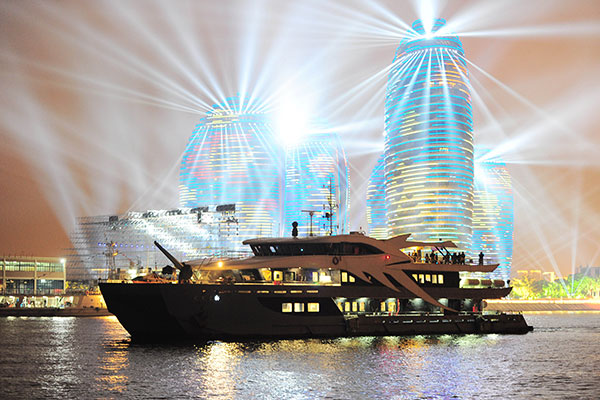
A yacht moves past the cruise ship hub in Sanya, Hainan province, during a nightly circuit in February.[Photo by Sha Xiaofeng/China Daily]
China’s reform and opening-up have brought life and prosperity to Hainan province and transformed it from a backward, remote island into one of the country’s most open and dynamic regions over the 30 years since it became a province.
Among the many changes, the upgrading of infrastructure is something a visitor can clearly see at every corner of the tropical island province, whose 30th anniversary falls on April 13.
There were no traffic lights in Hainan until the late 1980s, but the island has quickly become a destination for international tourists and events, with convenient transportation systems that link the province with the world — airports, harbors, expressways, high-speed railways and cruise lines, in addition to the internet, which connects local farmers with far-flung markets.
Through its transportation system, Hainan has established trade and cooperation links with more than 160 countries and regions around the world.
“Hainan will further expand its connections with countries and regions participating in the Belt and Road Initiative to open itself further,” Shen Xiaoming, governor of Hainan, said on April 9 during a panel discussion at the four-day Boao Forum for Asia Annual Conference 2018, which closed on April 11.
More cruise routes will be opened under its plan to make Hainan a hub of international trade and shipping in the South China Sea region, the governor said.
Phoenix Island in Sanya, with its Hawaii-like feel, has one 80,000-ton and two 150,000-ton berths for cruise ships, while Haikou, the provincial capital, has an 80,000-ton berth. Hainan greeted 319 cruises, including Voyager of the Seas and MS Europa 2 — touted as the world’s most luxurious cruise ship — which made port calls in Sanya last week.
The island has received 570,000 overseas tourists on cruises.
Another two berths, each with a 225,000-ton capacity, are close to being completed on Phoenix Island, according to local officials. The construction is a testament to Hainan’s ambition to turn Sanya into an Asian Miami, on par with Miami, Florida, in the United States, which is known as the cruise capital of the world.
The annual tourist capacity of the terminals is expected to reach 1 million by 2020, the governor said. He added that international flights will grow from the current 56 to 100 in three years as two major airports — Haikou Meilan International Airport and Sanya Phoenix International Airport — are expanding. The fifth airport on the island is taking shape on the western coast.
More choices are accessible on the roads. Its 653-kilometer high-speed railway around the island, the first such railway to circle a tropical island, opened in late 2015. It links 12 cities and counties along the coastlines, helping people to reach every corner on the island within two hours.
“Thirty years ago, it took a full day to reach Haikou from Sanya, which lies at the southern tip of the island, but now it takes less than two hours by high speed train, and there are other choices,” said Hua Zetian, a rice-breeding expert who has worked in Hainan for 30 years.
Construction of a sea-view tourism road circling the island is under way to help people see the waves from their own cars. More high-speed roads will help link every city and county in the central areas in the near future.
Meanwhile, the island had also upgraded its power and water supply systems.
For years, electricity shortages hindered the social and economic development of the province.
In 2016, the Changjiang Nuclear Power Plant in western Hainan began full operation, with two 650,000 kilowatt-hour power generators. It became a new driver for local development, supplying 27 percent of the island’s needs for electricity. It has turned the province into a leader in clean energy use.
From 2015 to 2017, Hainan invested 13 billion yuan ($2.1 billion) to upgrade its information service networks, which now reach all 2,573 villages on the island.
